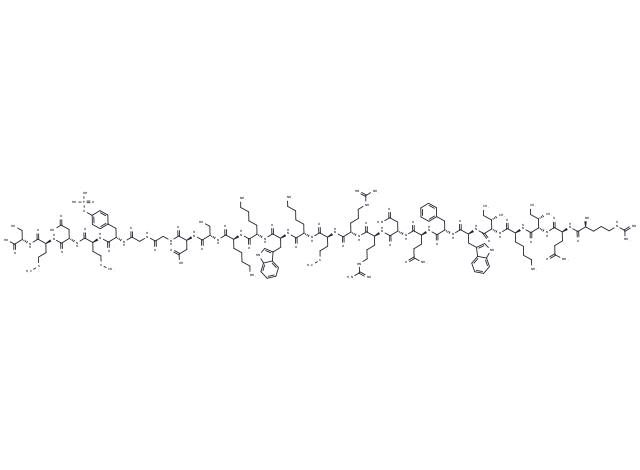Shopping Cart
- Remove All
 Your shopping cart is currently empty
Your shopping cart is currently empty

740 Y-P (740YPDGFR) is a potent and cell-permeable activator of PI3K.

| Pack Size | Price | Availability | Quantity |
|---|---|---|---|
| 1 mg | $89 | In Stock | |
| 2 mg | $139 | In Stock | |
| 5 mg | $265 | In Stock | |
| 10 mg | $393 | In Stock | |
| 25 mg | $658 | In Stock | |
| 50 mg | $937 | 7-10 days |
| Description | 740 Y-P (740YPDGFR) is a potent and cell-permeable activator of PI3K. |
| In vitro | 740 Y-P is a synthetic biotinylated peptide. 740 Y-P stimulates mitogenesis at the lowest concentration tested (1 mg/mL). The peptide stimulates mitogenesis in both the presence and absence of serum (0.5%) and in the former instance, a maximal response observed at 50 mg/mL. 740Y-P peptide to stimulate mitogenesis is highly specific and not a general feature of a cell-permeable SH2 domain-binding peptide [1]. 740Y-P is as effective as a growth factor (FGF2) at promoting neuronal cell survival via the established PI 3-kinase-Akt survival cascade. Stimulation of neuronal cell survival by the PDGFR740Y-P peptide is dose-dependent and does not require insulin[2]. |
| Alias | PDGFR 740Y-P, 740YPDGFR |
| Molecular Weight | 3270.7 |
| Formula | C141H222N43O39PS3 |
| Cas No. | 1236188-16-1 |
| Smiles | C([C@@H](C(N[C@@H](CC1=CC=CC=C1)C(N[C@H](C(N[C@H](C(N[C@H](C(N[C@H](C(N[C@H](C(N[C@H](C(N[C@@H](CC=2C=3C(NC2)=CC=CC3)C(N[C@H](C(N[C@H](C(N[C@H](C(N[C@H](C(NCC(NCC(N[C@@H](CC4=CC=C(OP(=O)(O)O)C=C4)C(N[C@H](C(N[C@H](C(N[C@H](C(N[C@H](C(O)=O)CO)=O)CCSC)=O)CC(O)=O)=O)CCSC)=O)=O)=O)=O)CC(O)=O)=O)CO)=O)CCCCN)=O)CCCCN)=O)=O)CCCCN)=O)CCSC)=O)CCCNC(=N)N)=O)CCCNC(=N)N)=O)CC(N)=O)=O)CCC(N)=O)=O)=O)NC([C@@H](NC([C@@H](NC([C@@H](NC([C@@H](NC([C@H](CCCNC(=N)N)N)=O)CCC(N)=O)=O)[C@H](CC)C)=O)CCCCN)=O)[C@H](CC)C)=O)C=5C=6C(NC5)=CC=CC6 |
| Relative Density. | 1.51 g/cm3 (Predicted) |
| Storage | store at low temperature,store under nitrogen | Powder: -20°C for 3 years | In solvent: -80°C for 1 year | Shipping with blue ice. | |||||||||||||||||||||||||
| Solubility Information | DMSO: 50 mg/mL (15.29 mM), Sonication is recommended. H2O: 5.5 mg/mL (1.68 mM), Adjust pH with HCl and sonication is recommended. | |||||||||||||||||||||||||
Solution Preparation Table | ||||||||||||||||||||||||||
H2O/DMSO
DMSO
| ||||||||||||||||||||||||||

Copyright © 2015-2025 TargetMol Chemicals Inc. All Rights Reserved.